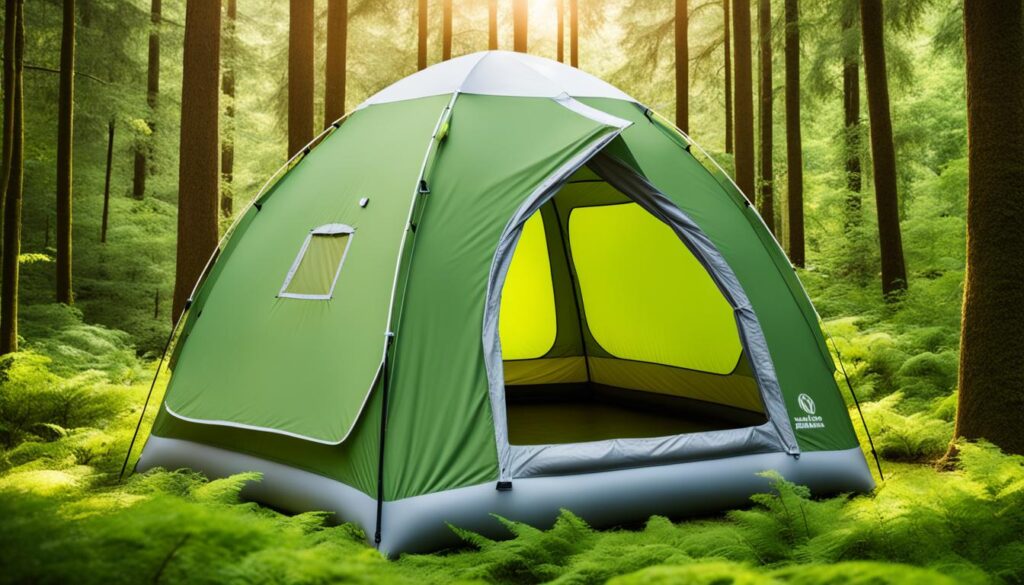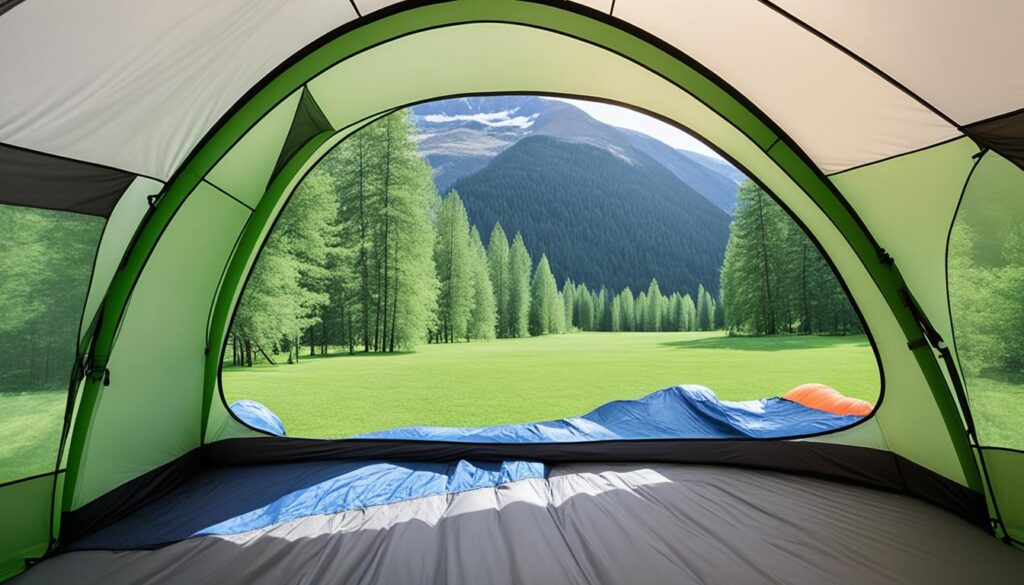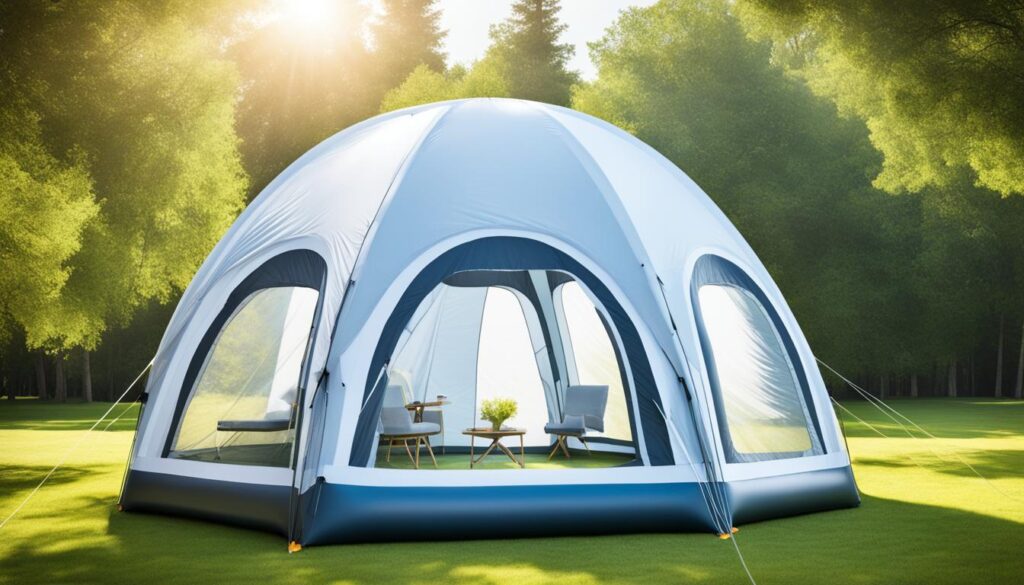
In recent years, eco-friendly camping has gained immense popularity among nature enthusiasts who are committed to reducing their environmental impact. As the demand for sustainable camping shelters grows, innovative solutions are emerging to cater to the needs of eco-conscious travelers. One such solution is the advent of eco-friendly inflatable tents, which not only provide comfort and convenience but also prioritize environmental sustainability.
Let me share a personal story that highlights the importance of eco-friendly camping and how inflatable tents contribute to this cause. Last summer, my family and I embarked on a camping trip to a picturesque national park. We were excited to reconnect with nature and unwind from our busy lives. However, upon arriving at the campsite, we were disappointed to see the negative impact of traditional camping practices on the environment.
The campsite was littered with discarded tent poles, broken pegs, and remnants of torn tents. It was evident that the ecosystem was struggling to recover from the environmental damage caused by previous campers. Determined to have a positive impact, we decided to explore alternatives that would allow us to enjoy the camping experience while minimizing our ecological footprint.
That’s when we discovered eco-friendly inflatable tents. These innovative shelters are crafted from environmentally friendly materials that reduce the use of non-renewable resources and harmful chemicals. With their sustainable manufacturing processes, these tents offer a guilt-free camping experience, knowing that we are not contributing to environmental degradation.
The inflatable design of these tents also appealed to us. Gone were the days of struggling with tent poles and complicated setup instructions. Inflating the tent was a breeze and allowed us to spend more time enjoying nature. Moreover, these tents are lightweight and compact when deflated, making them easy to carry during hikes and adventures.
Our experience with eco-friendly inflatable tents was nothing short of remarkable. Not only did we minimize our impact on the environment, but we also enjoyed the benefits of durability and versatility that these tents offer. They withstood unexpected weather conditions, provided ample space for our family, and allowed us to customize our camping setup according to our preferences.
By choosing eco-friendly camping shelters like inflatable tents, we realized that we could make a positive difference and protect the beauty of nature for future generations. If you’re passionate about sustainable camping practices and wish to embrace a greener way of experiencing the great outdoors, read on to discover the advantages, environmental benefits, and tips for selecting the perfect eco-friendly inflatable tent for your next adventure.
Key Takeaways:
- Inflatable tents provide an eco-friendly alternative for campers who prioritize sustainability.
- These tents are crafted from environmentally friendly materials, reducing the use of non-renewable resources and harmful chemicals.
- The inflatable design of these tents offers easy setup and portability.
- Eco-friendly inflatable tents are durable, versatile, and customizable.
- By choosing inflatable tents, campers can minimize their ecological footprint and protect the environment.
Advantages of Sustainable Inflatable Tents
Sustainable inflatable tents provide numerous benefits compared to traditional tents. With their portable and lightweight design, these tents offer convenience and ease of transportation during outdoor adventures and hikes. The use of inflatable beams or poles instead of traditional tent poles enables quick and effortless setup, saving time and effort for campers.
Despite their lightweight nature, sustainable inflatable tents are constructed using durable materials that are resistant to tears, punctures, and harsh weather conditions. This ensures their longevity and reliability, making them a wise investment for frequent campers.
In addition to their durability, these tents offer versatility and customization options. Many sustainable inflatable tents feature modular designs, allowing campers to personalize their camping experience by adding or removing sections according to their needs. This adaptability makes these tents suitable for different types of camping trips and varying weather conditions.
Moreover, sustainable inflatable tents contribute to eco-friendly camping practices. By reducing carbon emissions associated with the manufacturing and transportation of traditional tent poles, these tents assist in reducing the camper’s carbon footprint. Additionally, their lightweight design minimizes ground disturbance, preserving the natural surroundings and ecosystems. Sustainable inflatable tents are also constructed using eco-friendly materials, further enhancing their minimal impact on the environment.
Advantages of Sustainable Inflatable Tents:
- Portable and lightweight
- Durable and weather-resistant
- Versatile and customizable
- Reduced carbon footprint
- Minimal ground disturbance
- Constructed with sustainable materials
Overall, sustainable inflatable tents offer a practical and eco-friendly solution for campers who value convenience, durability, and sustainability. Their portable design, enhanced durability, and reduced carbon footprint make them an excellent choice for eco-conscious adventurers.
Environmental Benefits of Sustainable Inflatable Tents
Sustainable inflatable tents provide numerous environmental benefits that make them a wise choice for eco-conscious campers. By utilizing innovative design and materials, these tents contribute to minimizing the ecological impact of camping.
One key environmental advantage of sustainable inflatable tents is their ability to reduce carbon emissions. Unlike traditional tents that require metal or plastic tent poles, inflatable tents eliminate the need for these materials during manufacturing and transportation. By doing so, they help lower carbon footprints and promote a more sustainable camping experience.
The lightweight design of inflatable tents also plays a significant role in reducing environmental impact. Their lightweight nature allows for efficient transportation, resulting in reduced fuel consumption compared to heavier camping alternatives. This not only minimizes carbon emissions but also conserves valuable natural resources.
In addition to reducing carbon footprints, inflatable tents offer another significant benefit in terms of ground disturbance. These tents have a smaller footprint compared to traditional tents, causing minimal disturbance to the ground and surrounding ecosystems. This preservation of delicate habitats is crucial for maintaining the natural balance and biodiversity of camping locations.
Leading brands that prioritize sustainability also use eco-friendly materials in the construction of inflatable tents. These materials are often recyclable and free from harmful chemicals, ensuring safer and greener camping experiences. By choosing sustainable inflatable tents, campers can enjoy the outdoors while minimizing their environmental impact and promoting a more sustainable future.
Tips for Choosing the Right Inflatable Tent
When selecting an inflatable tent for your camping adventures, there are several important factors to consider. By keeping these tips in mind, you can ensure that you choose a tent that meets your needs for easy setup, durability, weather resistance, portability, and ventilation.
1. Easy Setup
Look for an inflatable tent that offers quick and effortless setup, allowing you to spend less time assembling the tent and more time enjoying the great outdoors. User-friendly designs with color-coded inflatable beams or poles can make the setup process a breeze, even for novice campers.
2. Durability
Opt for a tent made from high-quality materials that are built to withstand the rigors of outdoor use. Look for reinforced seams, sturdy construction, and tear-resistant fabric to ensure that your inflatable tent will stand the test of time and provide reliable shelter on your camping trips.
3. Weather Resistance
Choose an inflatable tent that offers excellent weather resistance to keep you comfortable in various conditions. Look for tents that are waterproof, wind-resistant, and equipped with UV protection to shield you from the elements. This will ensure that you stay dry, protected, and comfortable during unpredictable weather.
4. Portability
One of the main advantages of inflatable tents is their portability. When deflated, these tents should be lightweight and compact, making them easy to transport. Look for a tent that comes with a carrying bag or backpack for convenient storage and effortless transportation on your camping adventures.
5. Ventilation
Sufficient ventilation is crucial for a comfortable camping experience. Look for tents that feature multiple mesh windows, vents, or roof panels to promote airflow and reduce condensation inside the tent. Good ventilation will help maintain a fresh and breathable environment, especially during warmer seasons.
By considering these tips, you can confidently choose the right inflatable tent that offers easy setup, durability, weather resistance, portability, and ventilation, enhancing your camping experience and ensuring a memorable adventure in nature.

Comparison with Traditional Tents
Inflatable tents offer several advantages over traditional tents. Let’s explore how they outperform their conventional counterparts in terms of setup time, portability, durability, and weather resistance.
Setup Time
Setting up an inflatable tent is a breeze compared to traditional tents. With inflatable beams or poles, these tents can be inflated and secured in just a few minutes. No more struggling with complex pole systems or spending precious time figuring out assembly instructions.
Portability
When it comes to portability, inflatable tents take the lead. These tents are lightweight and compact when deflated, making them easy to carry and store. Whether you’re embarking on a backpacking adventure or planning a family camping trip, inflatable tents won’t weigh you down.
Durability
Inflatable tents are built to withstand the elements. Made from sturdy materials with reinforced seams and weatherproof coatings, they are designed to endure rugged outdoor conditions. Rest assured that your inflatable tent will stand strong against wind, rain, and whatever nature throws your way.
Weather Resistance
Just like traditional tents, inflatable tents offer reliable weather resistance. They are equipped with features such as waterproofing, wind resistance, and UV protection to keep you comfortable and protected in various weather conditions. Rain or shine, your inflatable tent will provide a secure shelter.
Overall, inflatable tents provide a more convenient and practical camping solution compared to traditional tents. They offer quick and easy setup, portability for on-the-go adventures, durability to withstand the elements, and reliable weather resistance. Say goodbye to the hassles of traditional tents and embrace the benefits of inflatable camping.

| Comparison | Inflatable Tents | Traditional Tents |
|---|---|---|
| Setup Time | Quick and easy with inflatable beams or poles | Time-consuming with traditional pole systems |
| Portability | Lightweight and compact when deflated | Bulky and often heavy |
| Durability | Sturdy materials with reinforced seams | May be prone to tears and wear |
| Weather Resistance | Waterproof, wind-resistant, and UV protected | Varies depending on tent quality |
Top 3 Inflatable Tent Products on Amazon
When it comes to inflatable tents, Amazon offers a wide range of top-rated options. Whether you’re a solo traveler, a couple, or a family, these three inflatable tents provide excellent features and durability for your camping adventures.
Coleman WeatherMaster 6-Person Air Tent
The Coleman WeatherMaster 6-Person Air Tent is a spacious and reliable choice for larger camping groups. This tent can comfortably accommodate up to six people and offers a variety of weather-resistant features to ensure a comfortable camping experience. The tent is constructed with sturdy materials that can withstand different weather conditions, keeping campers dry and comfortable throughout their trip.
Vango AirBeam Odyssey 500 Tent
For those seeking versatility and ease of setup, the Vango AirBeam Odyssey 500 Tent is an excellent option. This tent features an inflatable structure that allows for an effortless and quick setup process. With a spacious interior, the Vango AirBeam Odyssey 500 Tent provides ample room for sleeping and relaxing, making it an ideal choice for couples or small families.
Quechua Air Seconds 4.1 XL Fresh & Black Family Camping Tent
If you’re camping with your family, the Quechua Air Seconds 4.1 XL Fresh & Black Family Camping Tent is designed to meet your needs. This tent offers blackout technology, ensuring a dark interior conducive to a good night’s sleep. With its inflatable structure, the Quechua Air Seconds 4.1 XL Fresh & Black Family Camping Tent provides stability and ample space for the whole family to enjoy.
When choosing an inflatable tent, consider the size, features, and durability that best suit your camping needs. These top-rated options on Amazon offer a range of benefits to enhance your camping experience.
Conclusion
Sustainable inflatable tents offer an eco-friendly and practical solution for eco-conscious campers who want to minimize their environmental impact while enjoying the beauty of nature. These innovative tents provide quick and easy setup, making them convenient for outdoor adventures. With their lightweight and portable design, campers can easily carry them during hikes and other outdoor activities.
What sets sustainable inflatable tents apart is their commitment to environmental sustainability. By using these tents, campers can reduce their carbon footprint since they require fewer materials and resources to manufacture and transport compared to traditional tents. In addition, inflatable tents cause minimal ground disturbance, preserving delicate ecosystems and allowing nature to thrive.
The use of sustainable materials in inflatable tents is another important aspect. Many leading brands prioritize sustainability by using recyclable materials and ensuring their tents are free from harmful chemicals. By choosing eco-friendly camping gear like inflatable tents, campers can embrace more sustainable practices and contribute to the preservation of nature for future generations.
Source Links
- https://www.pomoly.com/Eco-Friendly-Camping-Sustainable-Inflatable-Tents-for-Nature-Lovers-a710026.html
- https://medium.com/@jamalbenhaddine.eco/inflatable-tent-the-ultimate-camping-game-changer-4271795ae4c3
- https://medium.com/@jamalbenhaddine.eco/5-must-have-features-for-your-next-inflatable-tent-adventure-7b1d4ff26af9

Meet Noah, the soul behind “Best Inflatable Tent” and a true wanderer at heart. Living the van life, Noah has turned his passion for exploring the great outdoors into a lifestyle, earning his living through organizing group travels that bring people closer to nature. With years of firsthand experience in the wild, Noah’s expertise in selecting and utilizing inflatable tents is unparalleled. Through this blog, he shares his profound knowledge and practical tips to help fellow adventurers find their perfect outdoor shelters. Noah’s commitment to delivering genuine, tested insights has made him a trusted authority in the camping community. Join him on this journey to discover the best inflatable tents that make the great outdoors feel like home.